When your pool in Queen Creek or San Tan Valley starts losing water faster than Arizona's desert heat can explain, you're faced with a crucial decision: tackle the leak detection yourself or call in professional underground scanning services. The choice isn't just about immediate costs: it's about understanding which approach prevents the most expensive problems down the line.
With water costs climbing and pool repairs potentially reaching thousands of dollars, Mesa and Gilbert homeowners need to make smart decisions about leak detection. While DIY methods offer immediate savings, professional underground scanning can prevent catastrophic structural damage, making the true cost calculation more complex than it initially appears.
Understanding Pool Leak Detection Fundamentals
Before diving into costs, let's establish what we're actually dealing with. Pool leaks fall into two main categories: surface-level issues you can see and diagnose easily, and hidden underground problems that require specialized detection equipment.
In Arizona's climate, normal evaporation can account for up to a quarter-inch of water loss daily during peak summer months. Anything beyond that likely indicates a leak that needs attention. The key is determining whether you're dealing with a simple surface crack or a complex underground pipe failure.
DIY Pool Leak Detection: The Budget-Friendly Starting Point
The Bucket Test: Your First Line of Defense
The most reliable DIY method starts with the bucket test: a simple technique that costs nothing but can save you from unnecessary panic. Fill a bucket with pool water, mark the water level in both the bucket and pool, and compare water loss after 24 hours. If your pool loses significantly more water than the bucket, you've confirmed a leak beyond normal evaporation.
This method works exceptionally well for Chandler homeowners dealing with Arizona's intense sun and low humidity. It eliminates the guesswork about whether water loss is from evaporation or an actual structural problem.
DIY Detection Strengths and Costs
DIY approaches excel at identifying obvious surface leaks. Basic patching supplies cost only $30 to $45, making this approach attractive for visible cracks in pool liners, damaged skimmer gaskets, or loose pool light fixtures.
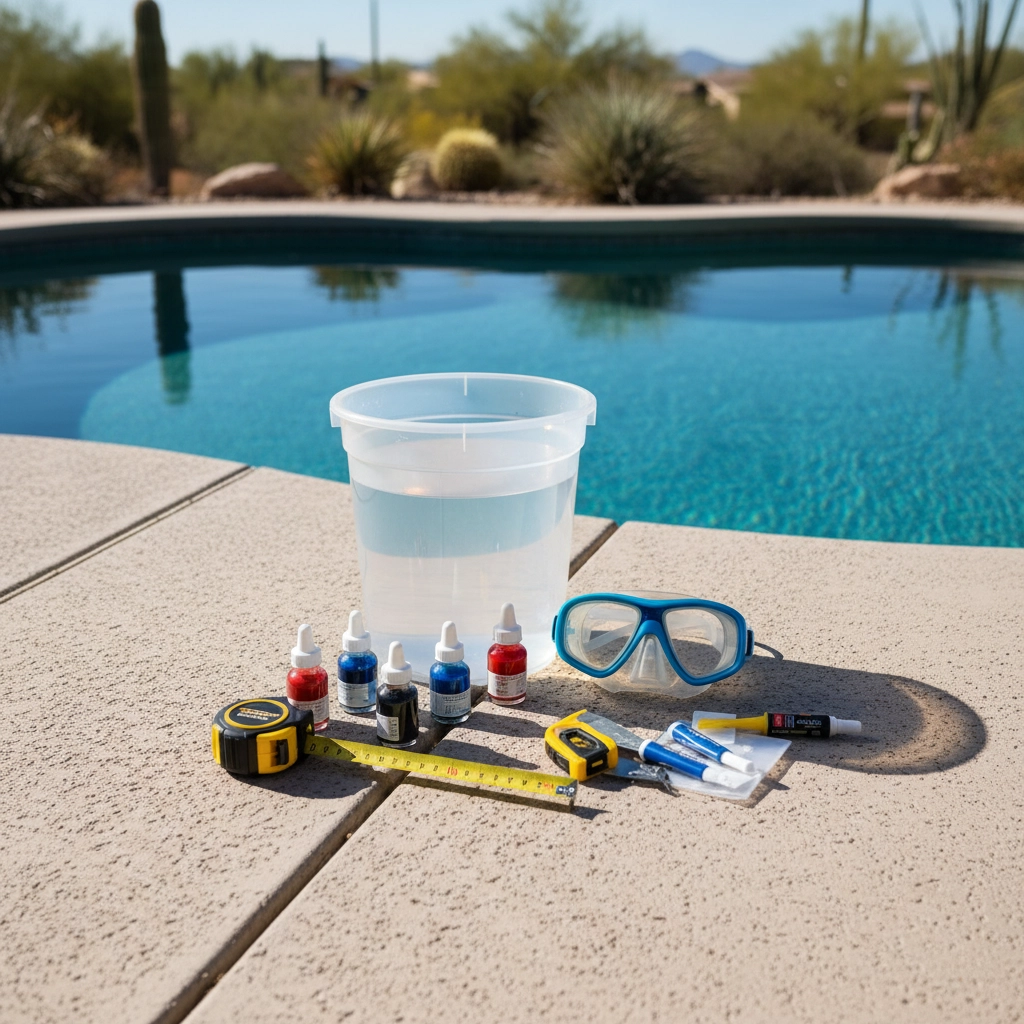
Common DIY tools include food coloring for dye testing around suspected leak areas, underwater goggles for visual inspection, and basic patching materials for immediate repairs. These methods work well when you can physically see the problem: think cracked tiles, separated coping, or damaged pool equipment connections.
Where DIY Falls Short
The limitations become apparent with hidden leaks. Without specialized equipment, you cannot detect problems in underground pipes, behind pool walls, or within the structural foundation. Many Queen Creek pool owners mistake normal evaporation for leaks or miss the actual source entirely, leading to delayed repairs that allow small problems to escalate into major structural damage.
DIY methods rely heavily on trial-and-error approaches. You might patch one area only to discover the leak continues because the real source was somewhere else entirely. This guesswork can result in multiple repair attempts, quickly eliminating any initial cost savings.
Professional Underground Scanning: Advanced Technology Meets Expertise
The Technology Behind Professional Detection
Professional leak detection services in Mesa and Gilbert employ sophisticated technology that eliminates guesswork. Acoustic sensors detect sound variations from escaping water, even through concrete and underground piping. Infrared cameras identify temperature changes indicating leaks behind pool walls or under decking.
Electronic listening devices work through solid materials to pinpoint exact leak locations, while pressure testing checks the integrity of entire plumbing systems. These methods provide comprehensive diagnostics that would be impossible to achieve with DIY approaches.
Cost Structure and Investment Returns
Professional pool leak detection typically costs between $100 and $500 in the Arizona market, with an average of $300 for standard residential pools. Complex underground investigations can reach $1,000, but this investment often prevents thousands in structural damage.
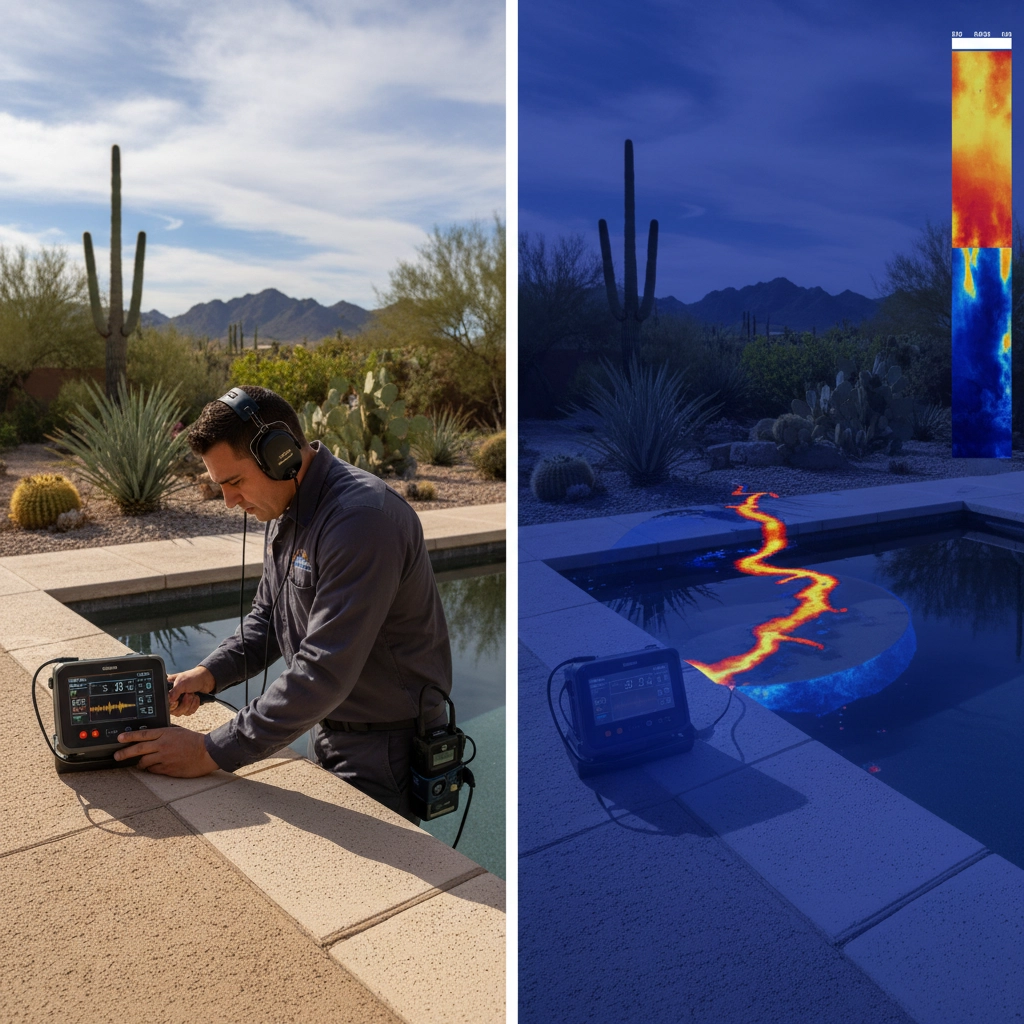
The key value proposition isn't just accuracy: it's prevention. Catching hidden underground leaks early can save San Tan Valley property owners significant money by preventing serious foundation issues, landscape damage, and skyrocketing water bills that can persist for months if leaks go undetected.
Advanced Detection Methods
Professional services use multiple detection methods simultaneously. Thermal imaging reveals temperature variations that indicate water movement behind walls or underground. Dye testing with professional-grade tracers can follow leak paths through complex plumbing systems. Pressure testing isolates specific sections of plumbing to identify exact failure points.
This comprehensive approach ensures that technicians address the actual problem rather than symptoms, preventing the common DIY mistake of patching visible damage while missing the underlying cause.
Cost Analysis: Breaking Down the Real Numbers
Upfront Investment Comparison
| Approach | Initial Cost | Accuracy Rate | Underground Capability |
|---|---|---|---|
| DIY Methods | $30-45 supplies | 60% for visible leaks | None |
| Professional Scanning | $100-500 service | 95%+ all leak types | Complete |
Long-Term Financial Impact
The true cost comparison extends beyond initial fees. DIY misdiagnosis can lead to multiple repair attempts, with each failed attempt costing additional materials and time. Meanwhile, undetected underground leaks can cause structural damage reaching thousands of dollars in repair costs.
Professional detection provides accurate diagnosis on the first visit, eliminating repeat service calls and preventing escalation of minor issues into major structural problems. For Chandler homeowners, this accuracy translates to significant long-term savings.
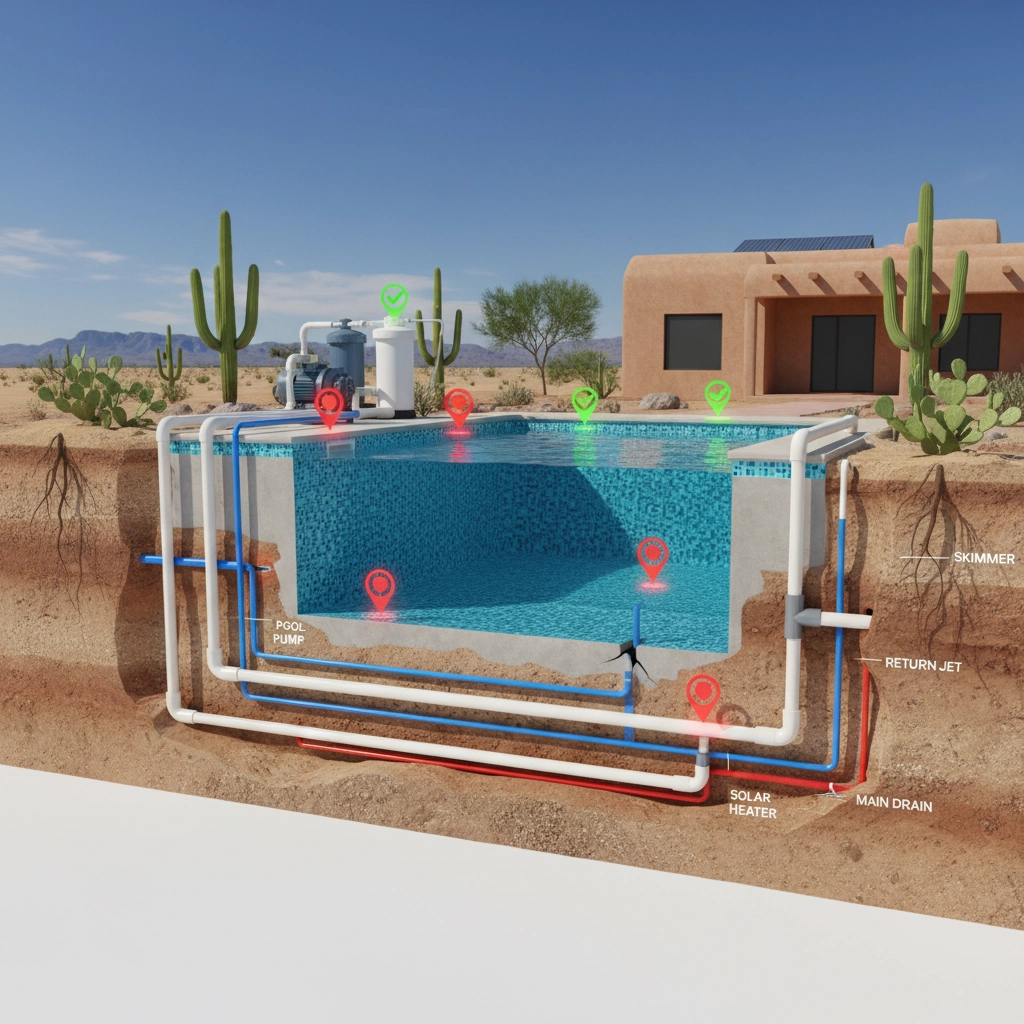
Hidden Costs of Delayed Detection
Water waste represents an ongoing expense that many homeowners underestimate. A small underground leak can waste hundreds of gallons weekly, creating utility bills that quickly exceed the cost of professional detection. In Arizona's water-conscious environment, these costs multiply rapidly.
Structural damage from undetected leaks includes foundation settlement, landscape destruction, and potential damage to pool equipment. These secondary costs often exceed the original leak repair by substantial margins.
Strategic Decision-Making: When to Choose Each Approach
DIY Makes Sense When:
Surface damage is clearly visible and accessible. You can see cracked tiles, separated pool coping, or damaged equipment connections. The bucket test confirms a leak, and you can physically identify the problem area within an hour of inspection.
Above-ground pools or spas with simple construction benefit most from DIY approaches. These installations typically have accessible components and straightforward leak sources that don't require specialized detection equipment.
Professional Scanning Is Essential When:
Water loss continues despite DIY repairs, indicating hidden sources. Your pool shows severe or accelerating water loss: more than a quarter-inch daily beyond normal Arizona evaporation rates. Underground pipe damage is suspected, particularly in older Gilbert or Mesa installations with aging plumbing systems.
Complex in-ground pools with multiple pumps, heaters, and plumbing lines require professional expertise. These systems have numerous potential failure points that DIY methods cannot effectively diagnose.
The Hybrid Approach: Maximizing Cost Effectiveness
Strategic Combination Method
The most cost-effective strategy combines both approaches intelligently. Start with a DIY bucket test to confirm leakage beyond normal evaporation. If the test indicates a problem but you cannot locate the source within reasonable inspection time, immediately call professional services rather than allowing continued water loss.
This approach minimizes both immediate costs and long-term damage risk. You avoid paying for professional services when obvious surface repairs are sufficient, while preventing expensive structural damage when complex issues require specialized detection.
Building Professional Relationships
Establishing relationships with local Queen Creek or San Tan Valley pool service providers offers additional cost benefits. Regular maintenance relationships often include reduced rates for leak detection services and priority scheduling during peak season when leaks commonly occur.
Annual professional inspections can identify potential problems before they become actual leaks, offering the ultimate cost savings through prevention rather than reactive repairs.
Making the Money-Saving Choice
The question of which approach "actually saves money" depends entirely on leak complexity and detection timing. For simple, visible surface repairs, DIY methods provide clear cost advantages. For hidden underground issues, professional detection prevents the kind of structural damage that costs exponentially more than the average $300 detection fee.
Arizona pool owners should consider leak severity, pool complexity, and their comfort level with diagnostic uncertainty when making this decision. The most expensive choice is often delayed action: allowing leaks to persist while attempting multiple DIY fixes that don't address the underlying problem.
Smart homeowners in Mesa, Gilbert, Chandler, Queen Creek, and San Tan Valley recognize that strategic professional investment often represents the true money-saving choice, preventing thousands in structural damage while ensuring accurate repairs that solve problems permanently rather than temporarily.
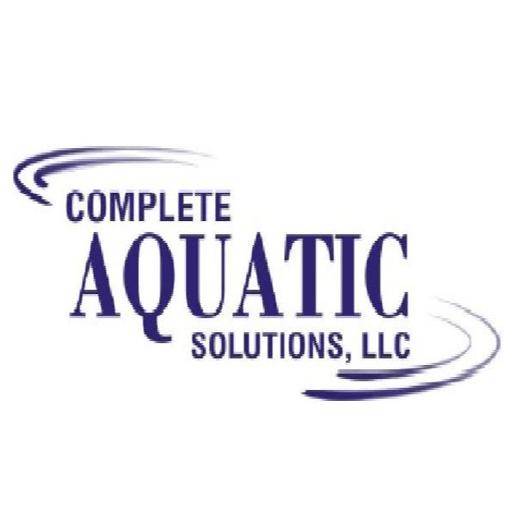
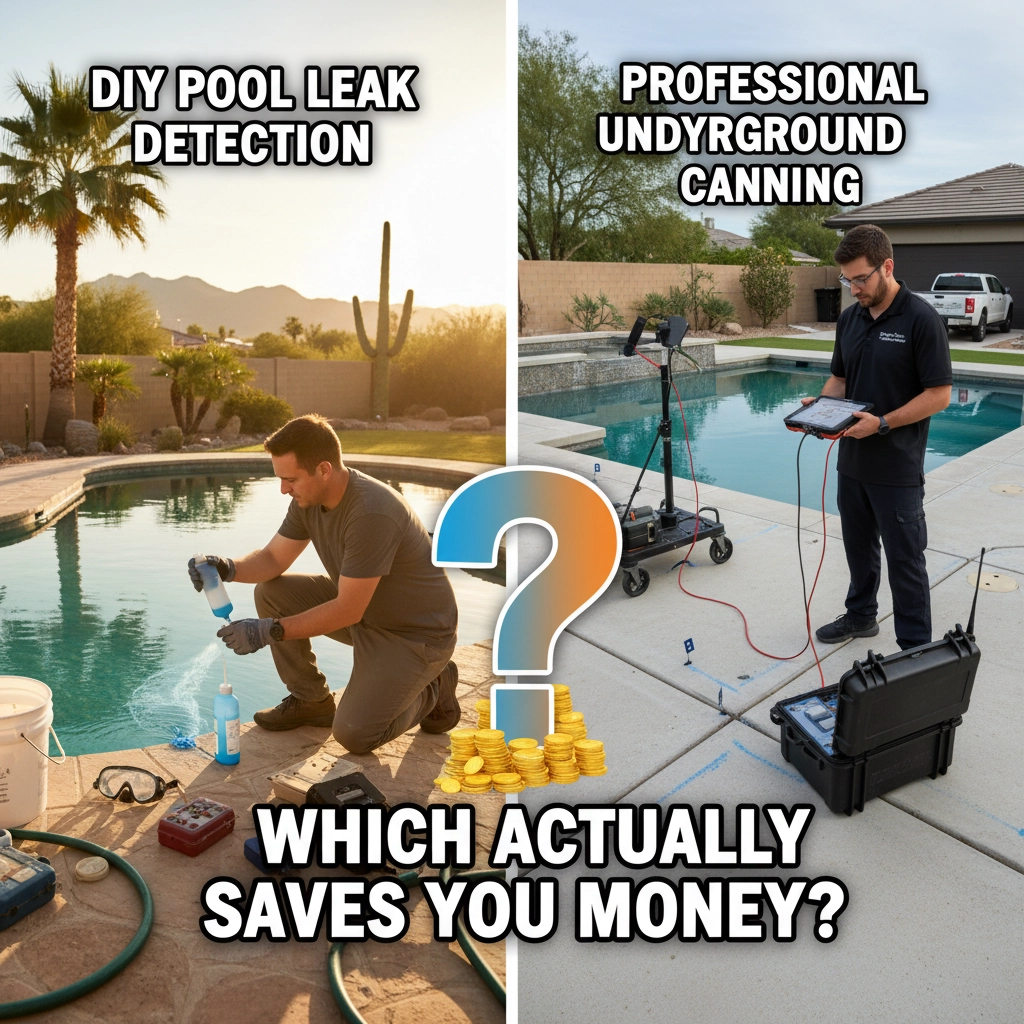
0 Comments